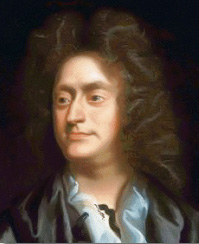November 6, 2011
Entire contents copyright 2011 by Carol Larson. All rights reserved.
 |
| Henry Purcell, composer, 1659-1695. |
What a grand partnership: the Choral Arts Society under the baton of James Rightmyer; and Bourbon Baroque, Louisville’s period instrument ensemble. This is a match made in heaven.
The Program began with the Funeral March from the Oratorio (Sacred Drama), Saul, by Handel. This movement is a funeral anthem for Saul and his son Jonathan. The music is gorgeous and the long sustained phrases were beautifully executed by the Orchestra.
The next piece was Music for the Funeral of Queen Mary, written by Henry Purcell, the greatest English composer before Handel. Mary was the wife of William of Orange who took the throne in 1688. Mary died in 1694 during the smallpox epidemic. This piece was an incredible experience. The eerie drum procession created the funeral mood of the piece. The music of the March was sad but a beautiful blend of brass sounds. The choruses and brass canzone were quite stunning. Conductor James Rightmyer did an excellent job, demanding precise rhythms of the orchestra and straight, blended tones of the chorus.
We now leave the Baroque period and come forward to the 20th century to the music of English composer Herbert Howells. Howells studied at the Royal College of Music under Charles Villiers Stanford, Hubert Parry and Charles Wood. He also was a good friend of Ralph Vaughn Williams, who was his mentor. The motet, Take Him, Earth, for Cherishing, was written shortly after President John F. Kennedy was assassinated and is dedicated to Kennedy’s memory. This work is considered to be Howell’s finest a cappella anthem. The chorus did an amazing job – the close harmonies were so in tune that they were as clear as a bell. It was magical!
The afternoon ended with the Magnificat in D major, BWV 243, by Johann Sebastian Bach. It is scored for orchestra, five-part chorus and soloists. The text is taken directly from the Gospel of Luke. The scene is the Virgin Mary visiting her cousin, Elizabeth, who is pregnant with the future John the Baptist. After Mary greets Elizabeth, the child moves in Elizabeth’s womb. Elizabeth then praises Mary for her faith and at this point Mary speaks what is now known as the Magnificat.
The choruses in this piece were performed at very brisk tempos, which seemed a little frantic at times; however, the solo and ensemble sections were very solid.
This was a beautiful concert and I hope these two ensembles partner again very soon to give us more beautiful music. Bravo to Mr. Rightmyer, the Choral Arts Society and Bourbon Baroque.
The Choral Arts Society and Bourbon Baroque
St. Martin of Tours Catholic Church
639 South Shelby Street
Louisville, Kentucky




